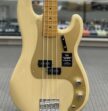Finding Your Groove: A Friendly Guide to Choosing a Bass Guitar
Contents
A bass guitar holds down the rhythm, shapes the harmony, and adds depth to music across every genre, from jazz and funk to metal and pop. Unlike other instruments, its low-end frequencies connect rhythm and melody, bridging the gap between percussion and harmony. The electric bass became popular in the 1950s when it replaced bulky double basses, offering a compact build yet powerful sound that could drive modern performances. Whether electric or acoustic, its adaptability makes it the backbone of any band’s sound, defining groove and driving energy.
Exploring the World of Bass Guitars

source: riffsandlicks.com.au
There are many types of bass guitars for sale, catering to diverse musical styles and preferences. The classic 4-string version is the most common and beginner-friendly, offering simple fingering and a comfortable feel for long sessions. It’s perfect for mastering classic rock, pop, and soul grooves. In contrast, 5-string and 6-string basses expand range, adding deeper tones for genres like metal and jazz, where experimenting with extended notes is crucial. Players may also explore fretless or acoustic options, each variation introducing a unique response and tonal character suited to different performance settings.
Discover the Perfect Fit
Choosing the right bass involves more than sound preference, as it also includes playability, comfort, and personal connection. When browsing bass guitars for sale, start by considering the neck width and string spacing that suit your hand size and playing technique. The scale length matters too: shorter scales suit younger players or those preferring compact instruments, while longer scales provide greater sustain and resonance.
Weight distribution is another deciding factor, as a well-balanced bass prevents fatigue during standing performances. The combination of these elements determines how naturally an instrument fits into a musician’s style and enhances their ability to perform confidently. Deciding on purchasing one of the reliable bass guitars for sale can truly elevate your musical journey by aligning comfort, creativity, and tone versatility.
The Right Choice Matters
An instrument that feels right can completely change how a musician learns, writes, and performs. Beyond aesthetics, it influences tone clarity, note precision, and enjoyment. Newer designs now include ergonomic contours, smoother fret edges, and responsive electronics for a modern playing experience. For instance, electric options with active pickups tend to provide bold output for live shows, while passive pickups deliver vintage warmth preferred in studio recording. For acoustic playing or mellow genres, hollow and semi-hollow body designs showcase natural resonance that fits softer sets.
Materials, Craftsmanship & Quality
Build materials significantly affect how a bass sounds and feels. Woods such as alder and ash produce balanced tones with bright attack and strong midrange, while mahogany creates warmth and long sustain, ideal for soulful music. Maple necks add clarity and definition, whereas rosewood fingerboards mellow out overtones for smoother textures.
Hardware, from bridges to tuners, also contributes to tuning stability and tone consistency, especially during live sessions. The quality of craftsmanship shows in how comfortably necks glide between frets and how precisely pickups transfer each vibration into sound. These subtle elements often distinguish a beginner-level instrument from one made for professional reliability and tone control.
Exploring Alternatives and Practical Choices

source: riffsandlicks.com.au
Modern players have more options than ever when it comes to instrument design. Certain models emphasise lightweight construction, allowing better mobility for stage performance. Others introduce hybrid body shapes or multi-scale fretboards that accommodate different tonal and ergonomic needs. Those who prefer experimental sounds often choose extended-range instruments that open up improvisational possibilities across new octaves.
When deciding, it’s wise to try both fretted and fretless styles, fretted versions maintain note accuracy, while fretless basses excel in expressive glissandos and nuanced tonal shifts. Pairing these features with amplifiers, pedals, and proper sound setup maximises sonic potential and brings out the full richness of the instrument’s tone.
Buying Tips for Every Player
Before investing, test how the instrument feels when played standing or sitting. Evaluate the neck’s comfort, listen for string buzz, and confirm that electronics function smoothly if it’s an electric model. The action, the distance between the strings and the fretboard, should allow effortless transitions without strain.
Beginners might start with simpler controls and lighter builds, while experienced players may prefer adjustable bridges or advanced tone knobs for precision tuning. Maintenance is equally important; regular cleaning and occasional string replacement preserve tone clarity and prevent oxidation. Exploring used options can also be worthwhile if they’re in good condition, as pre-played instruments often hold character at accessible prices.
Your Groove, Your Choice
Every musician eventually finds a bass that feels like an extension of their creativity. The joy lies in discovering how materials, design, and technique come together to define individuality. With countless bass guitars for sale catering to every style, players can experiment and grow, whether practising at home or performing live. The right selection nurtures confidence, enhances artistry, and ensures that every note resonates more than just sound, it reflects rhythm, passion, and the unique identity of the bassist shaping the music.






